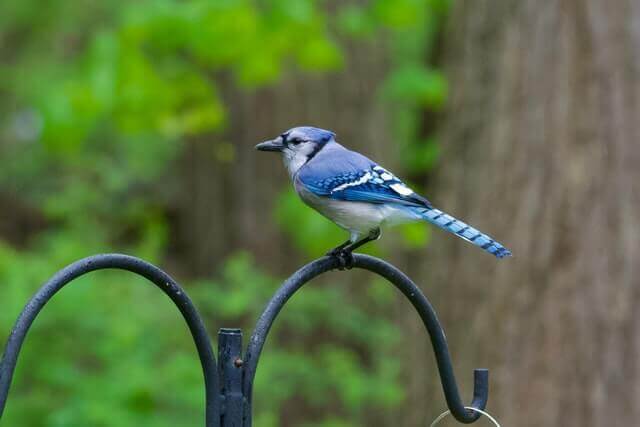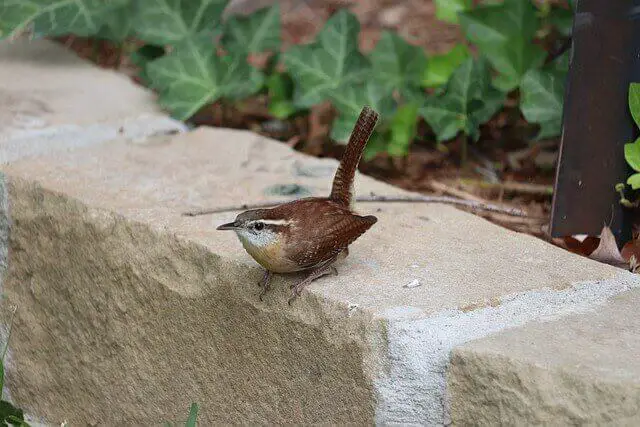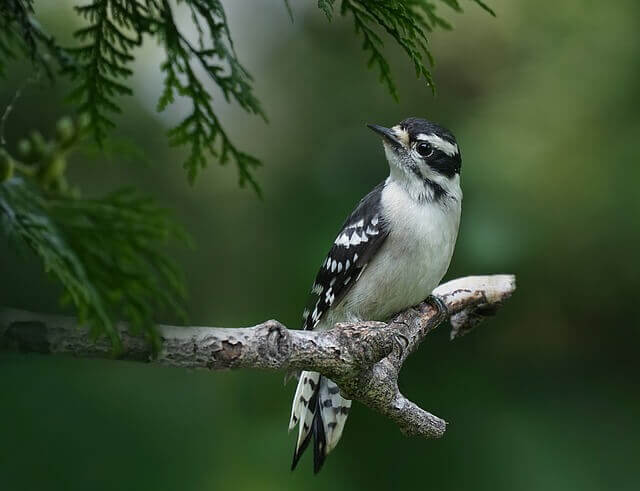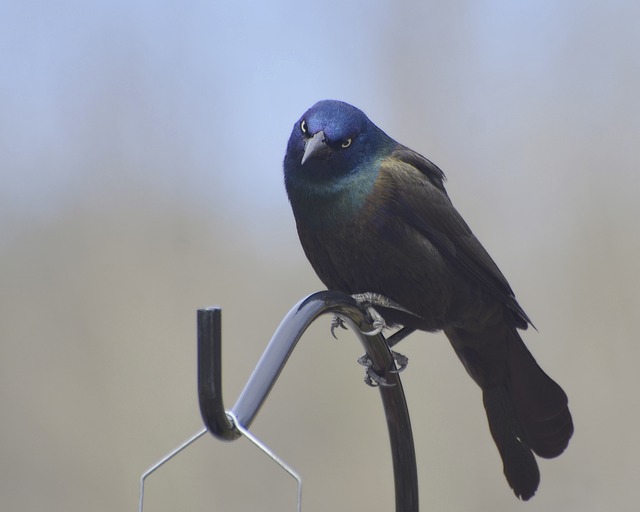Embark on a fascinating exploration of New Jersey’s diverse birding landscape with our comprehensive guide. This Ultimate Guide showcases the 62 most common birds found throughout the Garden State, offering detailed insights into their habitats, behaviors, and distinctive characteristics.
Whether you’re a dedicated birder, an outdoor enthusiast, or simply curious about New Jersey’s unique birdlife, this guide provides a captivating glimpse into the avian diversity that enriches this scenic state.
Table of Contents
- 1 Most Common Birds in New Jersey
- 1.1 Northern Cardinal
- 1.2 Mourning Dove
- 1.3 American Robin
- 1.4 Blue Jay
- 1.5 Song Sparrow
- 1.6 Red-winged Blackbird
- 1.7 Red-bellied Woodpecker
- 1.8 European Starling
- 1.9 Tufted Titmouse
- 1.10 American Goldfinch
- 1.11 Carolina Wren
- 1.12 American Crow
- 1.13 Downy Woodpecker
- 1.14 Gray Catbird
- 1.15 White-throated Sparrow
- 1.16 Common Grackle
- 1.17 House Finch
- 1.18 House Sparrow
- 1.19 Northern Flicker
- 1.20 White-breasted Nuthatch
- 2 Birdwatching in New Jersey
- 3 Top Birdwatching Hotspots in New Jersey
- 4 Attracting Birds to Your Yard: 5 Proven Tips
- 5 Explore the World of Bird Feeders: 10 Unique Types
- 6 Frequently Asked Questions
- 7 Author
Most Common Birds in New Jersey
Northern Cardinal
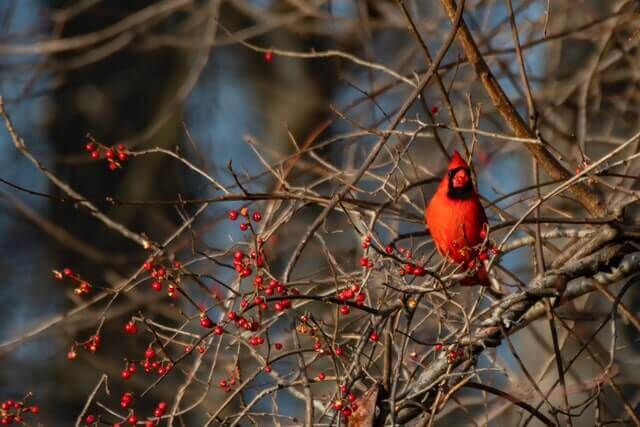
Northern Cardinals are a North American bird that is typically found in the United States and Canada. They are most commonly found in regions with woodlands, forest edges, thickets, overgrown fields and brushy pastures. The northern cardinal can be found all year round, with no migration pattern to speak of.
Northern cardinals eat mostly seeds and fruits as well as insects during the summer months while they eat primarily seeds during the winter months when there isn’t much fruit available.
- Frequency: 46.79% (eBird)
- Color: Mostly red with a black mask on the face, short pink bill
- Habitat: woodlands, gardens, parks, backyards, and wetlands
- Range: USA, Canada, Mexico
- Size: 8.2 – 9.3″ inches
- Weight: 33 – 65 grams
- Diet: Fruits, berries, and insects (grasshoppers, beetles, snails, cicadas)
- Family: Cardinalidae
- Genus: Cardinalis
Mourning Dove
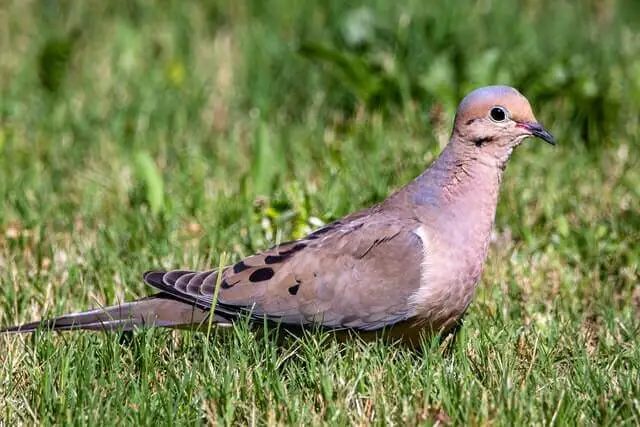
Mourning doves are one of the most common birds in North America. These small, gray-brown and white feathered songbirds can be found throughout the United States, Canada and Mexico. They have a preference for open areas with dense trees like agricultural fields, grasslands or marshes.
Mourning doves feed on seeds from weeds such as ragweed and millet that grow near water sources. The diet is supplemented by occasional insects including grasshoppers, beetles and caterpillars. During winter months they migrate to Mexico where their population declines due to lack of food availability.
- Frequency: 45.09%
- Color: Light gray-brown and lighter and pinkish below. The wings have black spots.
- Habitat: Open habitats, urban areas, farms, prairie, grassland, wooded area
- Range: USA, Canada, Mexico, Central America, Greater Antilles
- Size: 12″ inches length
- Weight: 112 – 170 grams
- Diet: Rapeseed, corn, millet, safflower, sunflower seeds, pokeberry, sesame, and wheat.
- Family: Columbidae
- Genus: Zenaida
American Robin

The American Robin is a migratory songbird found throughout North America. The majority of the bird’s habitat lies in the United States, with some territory in Canada and Mexico. This species prefers to nest near water sources such as streams or lakes where there are abundant insects for food. Robins feed on invertebrates such as earthworms, snails, millipedes and slugs.
Migrating from warmer climates during winter months, this songbird spends most of its time nesting in colder regions before returning southward again during springtime.
- Frequency: 44.39%
- Color: Mostly brown on the back with an orange colored breast
- Habitat: Wooded areas, backyards, parks, fields
- Range: USA, Canada, Mexico
- Size: 12 – 16″ inches
- Weight: 72 – 95 grams
- Diet: Fruits, berries and insects (earthworms, beetles, caterpillars
- Family: Turdidae
- Genus: Turdus
Blue Jay
The Blue Jay is a North American bird with an approximate range of eastern Canada to northern Mexico. The habitats of the blue jay are typically woodlands, urban areas and forests. They will also make their home in parks, backyards and yards if they have enough trees for nesting and feeding.
The diet of the blue jay consists mainly of nuts, seeds, fruits and insects such as caterpillars or spiders which it catches while perching on a branch close to the ground. Blue Jays have many migratory patterns depending on the time of year and region which they live in; some populations may migrate to warmer climates while some won’t.
- Frequency: 42.10%
- Color: Blue crest on the head, wings, back, and tail, and has a white face and belly
- Habitat: Deciduous and mixed forests, mixed woodlands, backyards, parks
- Range: Southern Canada, Eastern and Central United States, Florida and Texas
- Size: 8 – 12″ inches
- Weight: 70 – 100 grams
- Diet: Nuts, seeds, caterpillars, grasshoppers, and beetles
- Family: Corvidae
- Genus: Cyanocitta
Song Sparrow

The Song Sparrow is a common bird in North America, Europe and Asia. The song sparrow’s range includes North America, Canada, Central America, and South America in the summer months . It lives in habitats that include woods, fields, streamsides and farmlands. The diet of the song sparrow includes insects like ants or spiders, berries and seeds from plants such as dandelions or chickweed.
The migratory pattern of the song sparrow is very unpredictable, with many populations spending wintering periods throughout their range rather than just on one continent.
- Frequency: 36.64%
- Color: Gray head, white cheek, a black bib, rufous neck
- Habitat: Urban centers, farms, backyards, edges, yards, and parks
- Range: Europe, Mediterranean, Asia, Australasia, Africa, and the Americas
- Size: 5.5 – 7.0″ inches
- Weight: 25 – 40 grams
- Diet: Grains, seeds, and insects
- Family: Passeridea
- Genus: Passer
Red-winged Blackbird
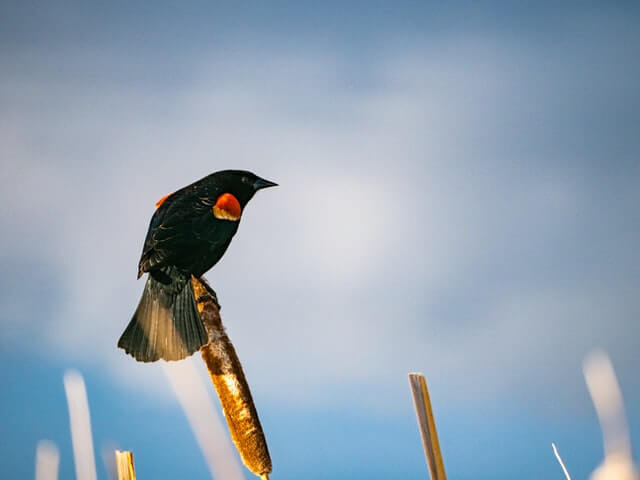
The red-winged blackbird is a member of the Icteridae family. They are found throughout North America, but mainly in southern Canada and the northern United States. This bird’s range includes nearly all habitats, including prairies, marshes, ponds and streams, cities as well as rural areas.
Red-winged blackbirds typically migrate to warmer climates during winter months or when food sources become scarce. In their range they have a diet consisting primarily of insects such as mosquitoes, beetles, dragonflies but will also eat seeds, and some berries.
- Frequency: 33.59%
- Color: All black with red patches on shoulder and a yellow wing bar
- Habitat: Deciduous forests, conifers, roadside, rivers, backyards, parks
- Range: North America, Central America
- Size: 6.7 – 7.1″ inches length
- Weight: 41.5 – 65 grams
- Diet: Seeds and insects (butterflies, dragonflies, moths, frogs, worms, spider, snails, carrion, flies.)
- Family: Icteridae
- Genus: Agelaius
Red-bellied Woodpecker
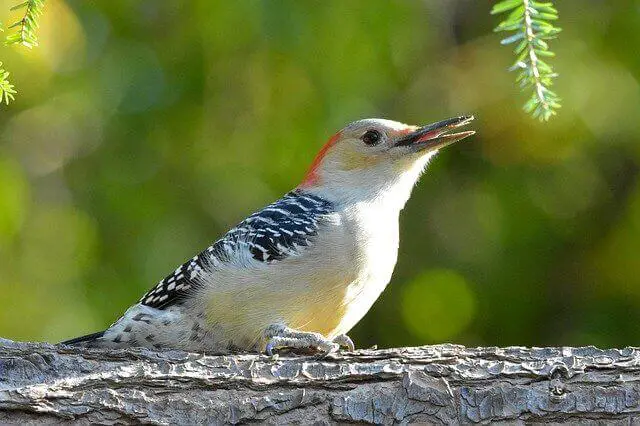
The Red-bellied Woodpecker is a small, stocky North American bird that is typically found in forested areas. It has a range from southern Canada to Mexico, but in the United States it can be found as far north as Maine and South Carolina. The majority of their habitat is deciduous forest, with areas of brush or pine trees nearby.
The diet for this species consists mainly of insects such as ants, beetles, caterpillars, and spiders which they find by tapping on trees. The red-bellied woodpecker migrates to Central America during winter months from November through March, where they find warmer temperatures than those available to them in North America.
- Frequency: 32.84%
- Color: Gray on body and face and underparts. Black and white pattern on wings, back, and tail.
- Habitat: Forests, backyards
- Range: Southern Canada, Eastern United States, Florida
- Size: 9 – 10.6″ inches long
- Weight: 56 -91 grams
- Diet: Insects, tree frogs, eggs of small birds, oozing sap, and small fish.
- Family: Picidae
- Genus: Melanerpes
European Starling
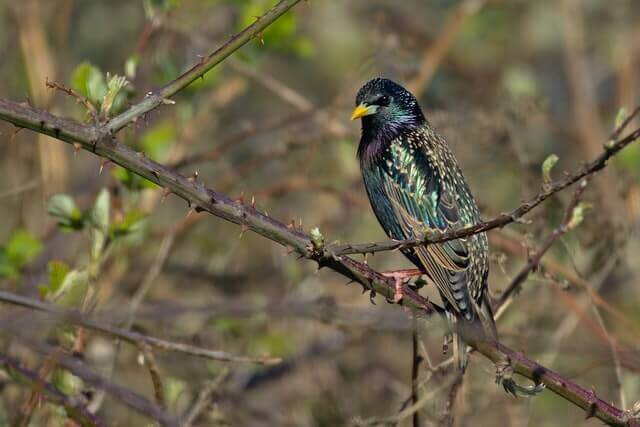
The European Starling is a bird that was introduced to North America by humans. The European Starling’s range is mainly across the eastern half of North America, but they are also found in some western states and southern Canada. They have been known to live in urban areas as well as rural towns. They inhabit open habitats such as farmland, orchards, parks and gardens; their nests can be found on tree branches or sometimes on the ground if there are no trees nearby.
The diet of the European Starling includes insects, spiders, worms and snails; it also feeds on grain crops such as wheat and corn. The migratory pattern for this species involves moving south in winter then returning north in spring or summer.
- Frequency: 31.63%
- Color: Black with glossy iridescence plumage
- Habitat: Forests, woodlands, backyards, edges, yards, and parks
- Range: North America, Europe, Africa, India, Middle East, China
- Size: 7 – 9″ inches long
- Weight: 60 – 100 grams
- Diet: Insects (ants, beetles, invertebrates), fruits, seeds, berries
- Family: Sturnidae
- Genus: Sturnus
Tufted Titmouse
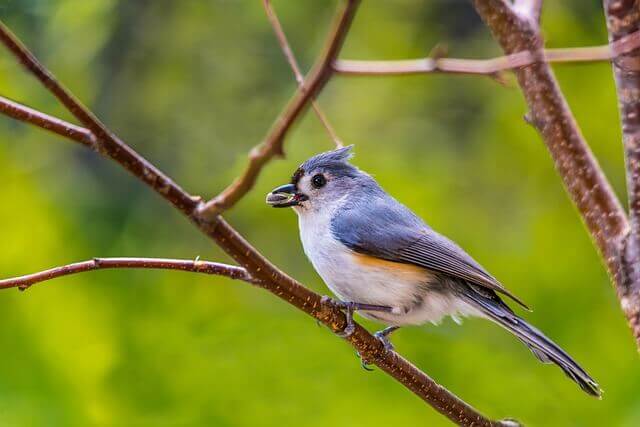
The Tufted Titmouse is a common songbird in North America. It is small, about six inches long, gray upper parts with rust-colored flanks, and has a tufted gray crest on its head. The tufted titmouse occurs in scattered populations in the southern states of the United States and Canada. In addition to its beautiful songs, this small bird has one of the brightest bird colors you can ever see.
The tufted titmouse likes to eat a variety of different foods including nectar, berries, seeds, insects, and mosquitoes. You will find the tufted titmouse in a number of places including wooded areas, gardens, backyards, fields, parks, and nesting areas. They feed during the nighttime. They nest in protected areas in spring and early summer and in old wooded areas in July and August.
- Frequency: 31.50%
- Color: Gray upper, white front, a tufted gray crest on the head
- Habitat: Deciduous forests, river basin, backyards, swamps
- Range: Canada, USA, and Mexico
- Size: 5.5 – 6.4″ inches
- Weight: 18 – 26 grams
- Diet: Nuts, insects, berries, seeds small fruit, and snails
- Family: Paridae
- Genus: Baeolophus
American Goldfinch
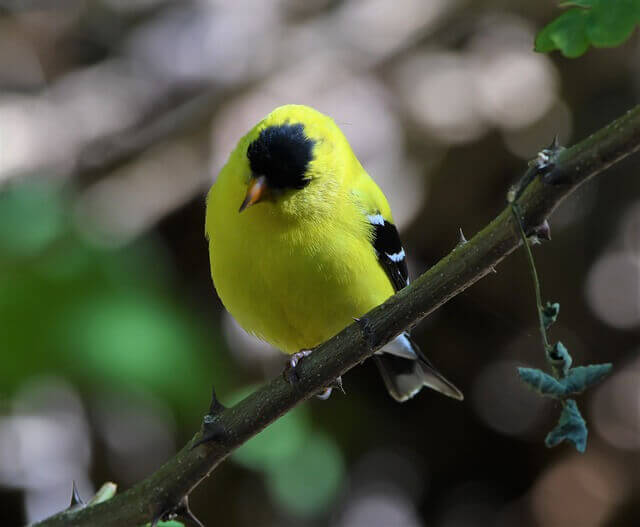
The American Goldfinch is a small bird that lives in North America. It has been found to be a common visitor at feeders and enjoys sunflower seeds, peanuts, safflower seed, and other types of nuts. The species can also be seen feasting on bugs such as ants or beetles.
The Goldfinch breeds throughout the United States, from Canada south to Florida and Texas. They migrate further south for winter time, when they enjoy spending their days perched high up in trees. They are mostly found on farmland, lawns, weedy fields, brushy borders and orchards with many types of fruit trees.
- Frequency: 31.43%
- Color: Face, neck, and underside are yellow, black wings with white bars
- Habitat: Deciduous forests and thickets, roadside, grasslands, backyards, meadows
- Range: Canada, USA and Mexico
- Size: 4.3 – 5.5″ inches length
- Weight: 12 -18 grams
- Diet: Grass, dandelions, chickweed, sunflowers and ragweed, thistle, red alder, birch, spruce seeds
- Family: Carduelinae
- Genus: Spinus
Carolina Wren
The Carolina Wren is uncommon, common species of wren that are still a regular resident in the central and eastern parts of the United States of America, particularly in the far north of Minnesota, the far south of Louisiana, and along the Gulf of Mexico on the east side of Texas. They are also occasionally seen in the southern states around Florida and along the Pacific coast. Carolina wrens prefer deciduous trees, so they are usually found in lowland forests.
Their preferred habitat remains near ponds and creeks where the trees have grown to be large and lush enough to provide them with plenty of cover and protection from predators, as well as water. For mating, Carolina wrens prefer to nest near nesting places such as cliffs, ledges, arbors, small islands, and other structures that provide good cover.
- Frequency: 31.03%
- Color: Black cap and throat with white cheeks. Light gray wings, back, and tail.
- Habitat: Deciduous forests, suburbs, parks, backyards
- Range: USA ( Texas, Florida, New Jersey, and Kansas)
- Size: 4.5 – 5.1″ inches long
- Weight: 9 – 12 grams
- Diet: Insects, berries, seeds
- Family: Paridae
- Genus: Poecile
American Crow
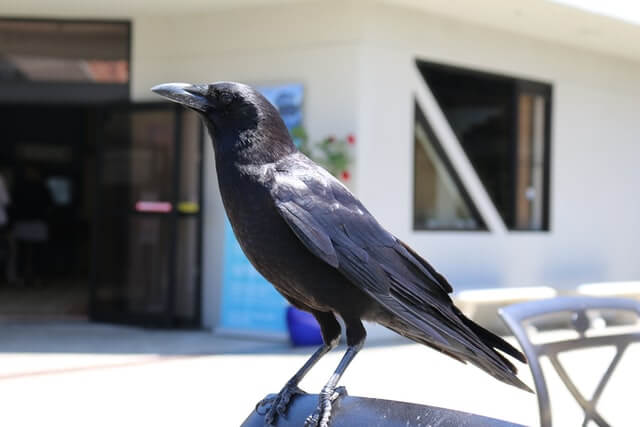
American Crows are common in North America. They can be found in all but the most extreme parts of Canada and the United States, with isolated populations along the southern border of Alaska and on the island of Newfoundland. They typically live in open woodlands or near water sources such as rivers, lakes, streams, ponds and marshes.
Crows prefer to build their nests in trees that are close to water sources. Crows will eat just about anything they can find including seeds, fruit, insects and worms which they scavenge from dead animals or dig up. In the winter, many will migrate south to warmer climates. The range for this species extends from Alaska and Canada in the north down to Mexico and South America in the south.
- Frequency: 30.84%
- Color: Black
- Habitat: Open country, farms, parks, woodlands, towns, cities
- Range: Canada, USA, Mexico
- Size: 16 – 21″ inches
- Weight: 315 -620 grams
- Diet: invertebrates, carrion, seeds, eggs fish, grains, mice, frogs, and other small animals.
- Family: Corvidae
- Genus: Corvis
Downy Woodpecker
Downy Woodpeckers are among the most common woodpecker species in North America. These birds have a large range, and can be found from Canada to Mexico. It lives in various habitats such as deciduous and mixed forests, woodlands, orchards, parks and gardens. They nest in tree cavities or other holes that they excavate themselves, as well as sometimes taking over abandoned nests of other animals.
Woodpeckers eat insects and grubs that live on trees, but also feed on fruits like acorns when they’re available. Downy Woodpeckers live all year round in the eastern U.S., migrating as far south as Florida during winter months, often traveling northward to breed.
- Frequency: 30.17%
- Color: Black with a white throat, belly, and back. White spots on wings
- Habitat: Deciduous forests and thickets, roadside, grasslands, backyards, parks
- Range: Canada, USA, and Mexico
- Size: 5.5 – 7.1″ inches in length
- Weight: 20 – 33 grams
- Diet: Mostly insects and beetles and ants, also gall wasps, caterpillars
- Family: Picadae
- Genus: Dryobates
Gray Catbird

The Gray Catbird (Dumetella carolinensis) is a small songbird of the Mimidae family, which includes thrashers and mockingbirds. The catbird’s range covers most of North America, from eastern Canada to Mexico. It is found in dense thickets and hedges near streams or swamps as well as woodland edges, open areas with tall grasses, and forest clearings where they feed on worms, insects, snails and berries.
During their migration they may fly as far south as Central America or South America where they spend winter months eating insects or nuts from trees.
- Frequency: 26.14%
- Color: Mainly Gray with black on tail and head, white accents on the body
- Habitat: Woodlands, marshes, meadows
- Range: East of the Canadian Rockies, Canada, USA, Mexico, Central America, and the Caribbean
- Size: 8 – 9.5″ inches
- Weight: 23 – 57 grams
- Diet: Fruits, berries, earthworms, beetles, bugs, ants caterpillars, grasshoppers, moths.
- Family: Mimidae
- Genus: Dumatella
White-throated Sparrow
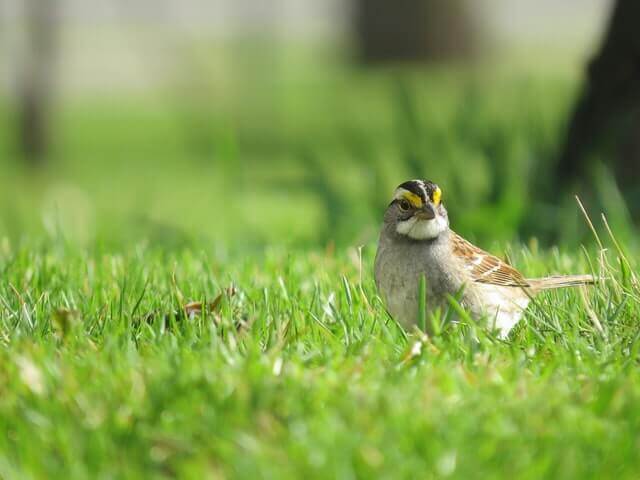
White-throated sparrows are migratory birds with a range that includes most of North America and parts of South America. These small birds prefer to live in open country, such as fields or meadows, rather than forested areas.
The White-throated Sparrow is a ground feeder that primarily eats seeds and insects while on its breeding ground; however, in winter, they will eat seeds and berries. They migrate south during the winter months to avoid freezing temperatures, and then return north when it starts getting warmer again.
- Frequency: 25.87%
- Color: Brown and gray head pattern. Black-and-white-striped head, white throat, and yellow near the eye.
- Habitat: Deciduous forests and thickets, roadside, grasslands, backyards
- Range: Eastern North America, Atlantic Canada
- Size: 5.9″ – 7.5″ inches long
- Weight: 22 – 32 grams
- Diet: Seeds, insects, and berries
- Family: Passerellidae
- Genus: Zonotrichia
Common Grackle
The Common Grackle is a bird that lives in the North America. They are found in most of Canada and Mexico, but they are not found as far south as Central America or South America. The birds also have a wide range across the United States, from east to west. Common Grackles live mostly near open fields with some water nearby, such as ponds or lakes.
There they find food like insects and other small animals, which makes up their diet during the summer months when they do not migrate. In the winter, Common Grackles will find food in open fields and pasture where they scavenge for insects like beetles, ants and caterpillars or take seeds from agricultural crops such as corn or oats that have been left behind by harvesters.
- Frequency: 25.11%
- Color: Black overall with a blue, and purple iridescence. Its body plumage is a shimmering copper color.
- Habitat: Woodlands, marshes, meadows, parks, backyards, and fields
- Range: East of the Canadian Rockies, Canada and the United States
- Size: 11 – 13″ inches length
- Weight: 75 – 143 grams
- Diet: minnows, eggs, berries, seeds, grain, insects, frogs, mice
- Family: Icteridae
- Genus: Quiscalus
House Finch
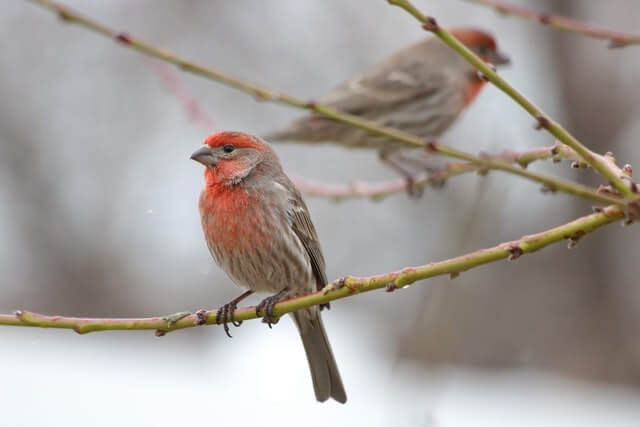
The House Finch is a small bird with a stout, conical bill. It is the most widespread North American finch and has been introduced to other parts of the world. The habitat of this bird includes open woodlands, shrubby areas and forest edges. Its diet consists mainly of seeds from weeds, grasses, corn, wheat and soybeans.
The House Finch range extends across all of North America east of the Rocky Mountains; its western limit runs through California but excludes the southwest desert regions west to Arizona and New Mexico. The house finch migrates for the winter to Central America, where they spend their time around tropical forests with plenty of fruit trees like banana plants or palm trees.
- Frequency: 23.63%
- Color: Reddish face and upper breast, brown streaks on back, belly, and tail.
- Habitat: urban and suburban areas, backyards, edges, yards, and parks
- Range: Canada, USA, Mexico
- Size: 5 – 6″ inches
- Weight: 16 – 27 grams
- Diet: Aphids, grains, seeds, berries, nettle, dandelion, sunflower
- Family: Fringillidae
- Genus: Haemorhous
House Sparrow
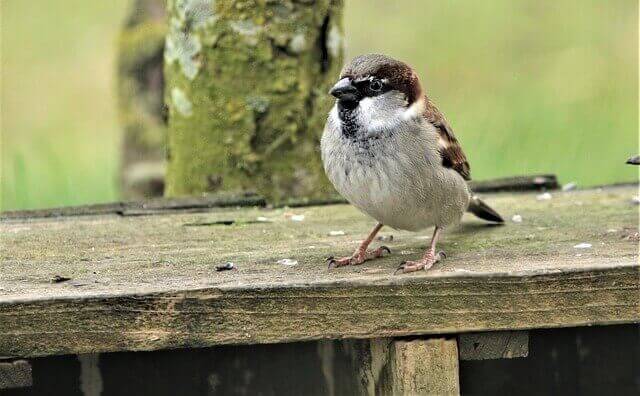
The House Sparrow is a small bird in the sparrow family. They have many colors, patterns and types of feathers. Their habitat includes cities, towns, and farmlands that are close to water sources like rivers or streams. These small birds are often found nesting on buildings, bridges and other man-made structures.
The diet of the house sparrow includes seeds from plants and weeds, as well as insects and other invertebrates found on the ground. Migration pattern varies depending on climate zones, but they tend to migrate south for winter when there is less food available in colder climates
- Frequency: 23.12%
- Color: Gray head marking, a reddish-brown back, and gray underparts
- Habitat: Urban centers, suburban areas, backyards, edges, yards, and parks
- Range: North America, Central America, South America, Africa, Australia, New Zealand
- Size: 5.5 – 7.1″ inches in length
- Weight: 25 – 39 grams
- Diet: Insects, beetles, caterpillars, aphids,, grasshoppers, crustaceans, earthworms, vertebrates
- Family: Passeridea
- Genus: Passer
Northern Flicker

The Northern Flicker is a woodpecker that lives in the North America. They live year-round in areas where they are not threatened by humans and their habitats include forests, brushy areas, residential neighborhoods, parks and campgrounds. The Northern Flicker’s habitat consists of forests or parks that have mature trees with exposed trunks and live branches for perching and hunting insects.
It primarily eats ants, beetles, bees, caterpillars, crickets, grasshoppers honeybees wasps among other things. During winter months, when food becomes scarce, they rely on suet feeders for sustenance. They migrate south during fall and return north once spring arrives.
White-breasted Nuthatch
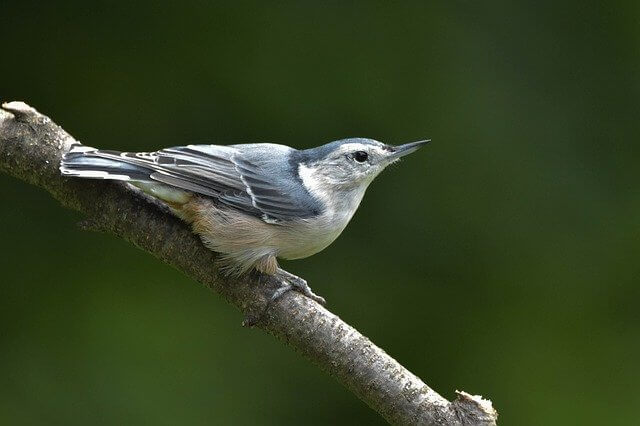
The White-breasted Nuthatch is a small bird species found in North America. The range of the white-breasted nuthatch includes Alaska, Canada and parts of the United States. They inhabit boreal forests and coniferous forests at higher elevations in western mountains. These birds are usually found on tree trunks or branches where they use their bills to search for insects such as ants, bark beetles, spiders and caterpillars that live on trees or logs.
The diet of these animals is primarily insects, but they also eat nuts, seeds, berries and other fruits from time to time. These birds can be found throughout most of the United States during the winter months, but migrate to Mexico for the summer months.
- Frequency: 22.69%
- Color: Has a white face, flanks, and chest. It has a black cap on its head a bluish-gray upper and a brown belly
- Habitat: Deciduous forests, conifers, roadside, rivers, backyards, parks
- Range: Southern Canada, USA
- Size: 5.9″ inches
- Weight: 20 grams
- Diet: Acorn nuts, hickory nuts, ants, caterpillars, scale insects, pine weevils
- Family: Sittidae
- Genus: Sitta
The backyard birds below have a frequency of less than 22%
- Northern Mockingbird (21.87% Frequency)
- Tree Swallow – 19.38%
- Carolina Chickadee – 19.37%
- Dark-eyed Junco – 18.11%
- Yellow-rumped Warbler – 16.15%
- Common Yellowthroat – 16.01%
- Brown-headed Cowbird – 14.23%
- Barn Swallow – 14.17%
- Fish Crow – 13.39%
- Chipping Sparrow – 13.37%
- Black-capped Chickadee – 12.41%
- Rock Pigeon – 12.06%
- Eastern Towhee – 12.00%
- House Wren – 10.70%
- Eastern Phoebe – 10.27%
- Cedar Waxwing – 9.89%
- Yellow Warbler – 9.72%
- Eastern Bluebird – 9.64%
- Field Sparrow – 9.47%
- Hairy Woodpecker – 9.41%
- Belted Kingfisher – 9.25%
- Blue-gray Gnatcatcher – 9.10%
- Killdeer – 8.78%
- Red-eyed Vireo – 8.06%
- Eastern Kingbird – 7.82%
- Chimney Swift – 7.70%
- American Redstart – 7.39%
- Great Crested Flycatcher – 7.36%
- Baltimore Oriole – 7.33%
- Swamp Sparrow – 7.22%
- Black-and-white Warbler – 6.88%
- Ruby-crowned Kinglet – 6.80%
- Indigo Bunting – 6.64%
- Ruby-throated Hummingbird – 6.64%
- Ovenbird – 6.06%
- Eastern Wood-Pewee – 6.01%
- Wood Thrush – 5.88%
- Palm Warbler – 5.85%
- Savannah Sparrow – 5.49%
- Northern Parula – 5.26%
- Northern Rough-winged Swallow – 5.06%
- Golden-crowned Kinglet – 5.01%
Birdwatching in New Jersey
New Jersey offers an enticing haven for birdwatchers beyond the confines of your backyard. Dive into the vibrant world of birding with the New Jersey Audubon Society, where you can join meetups, enrich your knowledge in workshops, embark on thrilling field trips, and participate in captivating birding tours.
Additionally, explore local birdwatching clubs, wildlife refuges, state and national parks, and vibrant online communities that provide a wealth of resources and opportunities to enhance your birdwatching experience in the Garden State.
Top Birdwatching Hotspots in New Jersey
If you’re a New Jersey resident seeking to expand your bird species checklist, here are some handpicked birding destinations across the state to explore:
- Great Swamp National Wildlife Refuge
- Cape May Point State Park
- Duke Farms
- Brigantine Wildlife Refuge
- High Point State Park
- Liberty State Park
- Island Beach State Park
- Edwin B. Forsythe National Wildlife Refuge
- Sandy Hook
- Cape May
Discover what each of these locations has to offer, including local birding events, by exploring Top Birdwatching Hotspots In New Jersey: Insider’s Guide!
Attracting Birds to Your Yard: 5 Proven Tips
Eager to invite these feathered wonders to your backyard? Here are five effective strategies to make your outdoor space a bird paradise.
- Set Up Bird Feeders The most straightforward approach is to introduce bird feeders. Start with options like tube feeders, hopper feeders, platform feeders, or window feeders. Each offers unique advantages.
- Install a Water Oasis Birds crave water for bathing and drinking. A pedestal birdbath or a simple terra cotta flower pot saucer can do wonders. Consider a solar fountain to entice them further with moving water.
- Provide Cozy Birdhouses Certain bird species are drawn to birdhouses, especially when placed strategically. Eastern Bluebirds, for instance, are a coveted sight. Offering suitable birdhouses can attract nesting pairs quickly.
- Offer Shelter and Safety Ensure your yard features trees, bushes, and shrubs where birds can find refuge from potential predators. Creating a safe environment is paramount for their well-being.
- Embrace Native Plants Many birds rely on native plants for nuts, berries, and seeds. Incorporating these plants into your landscape can significantly enhance your bird-attracting efforts. Avoid invasive or non-native species, which may be harmful to native birds.
Explore the World of Bird Feeders: 10 Unique Types
Bird enthusiasts have a variety of feeders to choose from when attracting feathered visitors to their yards. Here’s a look at 10 common types:
- Hopper Feeder: Featuring a seed compartment in a house-like structure, perfect for black sunflower seeds or mixed birdseed.
- Platform Feeder: Open tray feeders ideal for hanging or pole mounting, suitable for various bird species.
- Tube Feeder: Clear plastic tubes that keep seed fresh and attract a range of birds; great for black sunflower seeds and mixed seeds.
- Suet Feeder: Designed for suet cakes, favored by woodpeckers; opt for models with tail props for larger woodpeckers.
- Window Feeder: Small feeders that attach to glass windows, perfect for compact spaces; use black sunflower seeds or mixed birdseed.
- Thistle Feeder: Specialty feeders for thistle seed, attracting finches like American Goldfinch and House Finch.
- Ground Feeder: Tray feeders at ground level, popular with Mourning Doves, Juncos, and ground animals.
- Oriole Feeder: Specifically for orioles, offering jelly and orange halves; great for attracting these colorful birds.
- Hummingbird Feeder: Designed for nectar-loving hummingbirds, also appealing to Downy Woodpeckers; simple and budget-friendly.
- Peanut Feeder: Tube-shaped feeders with wider wire mesh holes for whole or shelled peanuts, attracting Blue Jays and others.
Each feeder type brings unique birdwatching opportunities to your backyard. Choose the one that suits your avian visitors and enjoy the show!
Frequently Asked Questions
What is the largest hawk in NJ?
A Rough-legged Hawk is the largest hawk in New Jersey. It is a migratory bird that travels from Canada to the United States in winter and back again in summer. They are almost 2 feet long and have a wingspan of around four and a half feet, and weigh about three pounds.
Are Blue Jays in NJ?
The blue jay (Cyanocitta cristata) is a native bird to the eastern United States. They are common throughout most of North America, and they can be found in New Jersey.
Do Blue Jays eat hummingbirds?
Blue Jays eat insects, seeds, nuts, berries and occasionally eggs or young animals such as squirrels or hummingbirds if given the chance.
Which Songbird is the state bird of New Jersey?
The American Goldfinch is the state bird of New Jersey. The goldfinch was officially designated as the state bird on June 27, 1935, but they were recognized by colonial settlers much earlier.
What is the rarest bird in New Jersey?
Cooper’s Hawk is the rarest bird in New Jersey. Cooper’s Hawks are a small hawk species, which was originally native to North America. This raptor has been spotted throughout many parts of New Jersey, but they are rare sightings.


